Monday 31 October 2011
Steppe Polecat - Wild Relative of the Domesticated Ferret
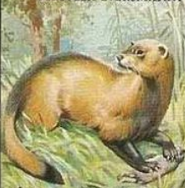
The steppe polecat (
Mustela eversmannii), also called the masked polecat, Eversmann’s polecat or the Siberian polecat, strongly resembles a pet ferret (
Mustela putorious fero.) Although biologists think the European polecat (Mustela putorious) is the direct ancestor of the domesticated ferret because the two species can interbreed, some biologists think that the steppe polecat may also be an ancestor to the pet ferret. Unlike domesticated ferrets, steppe polecats do not come in a variety of coat colors and are hostile to people.
Steppe polecats are found from Eastern Europe to China. Although not listed as threatened or endangered, steppe polecats primarily prey on large rodents like ground squirrels, marmots, water voles and pika. If the habitat for their prey is destroyed, then the steppe polecat will lose a major food supply. Steppe polecats have been observed eating lizards, frogs, willow grouse and grey partridges. Natural predators include birds of prey,
jackals, stray dogs and foxes. Humans also prey on them, trapping steppe polecats for their fur and accidentally kill polecats trying to cross roads.
Physical Description
Steppe polecats grow larger than domesticated ferrets. They average 2 feet (60 cm) in length. Males are larger and heavier than females. One male in the wild grew to 31.5 inches (80 cm), but this is considered unusual. Males tip the scales at 72.31 ounces (2,050 grams) while females only average 47.61 ounces (1,350 grams.)
Steppe polecats possess long weasel-like bodies, short legs and a triangular head. Their bodies are chestnut-brown with a dark dorsal stripe going down the spine to the tail and black feet. Their heads, undersides of the chest and belly are white, but there are dark brown markings over the eyes which make it appear as if the steppe polecat was wearing a bandit’s mask. Their lips and sometimes the tips of their noses are pink. Their winter coat is much thicker and slightly longer than their summer coats.
Life Cycle and Behavior
Steppe polecats prefer to live in grasslands, bases of mountains and arid deserts, but can also make homes in cultivated fields and pastures. They are most active at dusk and dawn. Each steppe polecat has several burrows in its territory. It prefers to commandeer the burrows of ground squirrels rather than dig its own. Each polecat lives by itself. Females keep permanent territories while males have territories overlapping females. The sexes only get together for mating in March and April.
After a gestation of 36 to 43 days, females give birth to one to eighteen kits or baby polecats. They are born blind, deaf and hairless. They stay in their mother’s burrow for two to three months, then come up and begin to learn to hunt. They can take down an adult ground squirrel by the time they are three months old. They soon leave their mother and fend for themselves. Although they can breed sooner, the kits do not become physically mature until they are two years old. It is unknown how old steppe polecats can live in the wild.
You can help spreading the word about this animal by liking it on facebook
Permanent Link
Friday 28 October 2011
The Japanese Macaque - Hot Springs-Loving Similian

The Japanese macaque (
Macaca fuscata), which is also known as the snow monkey, is famous throughout the world for its love of soaking in hot springs on cold winter days. This very human-like behavior has endeared them to those who have seen images of the little monkeys, their fur covered in snow, peeping out from the steaming water.
Japanese macaques have a naked, red to pinkish face. Its fur ranges in color from brown to gray, and it has a short, approximately three-inch tail. In the winter, the macaques that live in the colder regions grow a thick winter coat. On average, Japanese macaques weigh approximately 18 to 24 pounds (11 kg to 8 kg) and are about 20 to 22 inches (522 to 570 mm) in length. Male Japanese macaques are typically slightly larger than females.
The Japanese macaque can be found on three of Japan's four main islands. The only island they do not live on is the northernmost, Hokkaido. The Japanese macaque lives in a wide range of habitats, from lowlands to mountains to by the ocean. Populations can be found on Shimokita Peninsula on Honshu Island, the Nagano Mountains, by the ocean on Oshima Island, and on the southern island of Yaku-Shima. It is the only monkey that lives as far north of the equator as it does.
These monkeys are omnivores. Their diet typically consists of fruit, leaves and insects. They have also been known to consume crabs, fish and eggs. In northern areas, where the winters can be harsh, the Japanese macaque will feed on bark. Some macaques will wash their food in salt water to both clean and flavor it.
The Japanese macaque are highly sociable animals. They live in troops that are typically made up of about 30 to 40 monkeys, though larger groups have been known to exist. Though these troops do have a dominant male, other male monkeys are allowed to stay in the troops. Female macaques also have a pecking order, with offspring of high-ranking females typically enjoying a high rank in the troop, as well.
The macaque’s now famous habit of soaking in hot springs was first noted in 1963 when one monkey in the Nagano Mountain region ventured into the springs to retrieve an item. Soon, other monkeys followed suit. Nowadays, it is a common practice for the troops in this region to soak in the hot springs. Macaque babies in this region have also been seen creating and playing with snowballs.
Predators of the Japanese macaque include dogs, mountain hawk eagles and humans. Unfortunately, the Japanese macaque is not a shy animal and troops have been known to raid crops on farms and snatch food from children and others. Though they enjoy a protected status, they are occasionally killed by humans angered by their behavior. Loss of habitat has also led to a decline in the Japanese macaque’s population. The Japanese macaque is listed on CITES’s Appendix II, meaning that its trade is monitored and its conservation status is listed as of Least Concern by IUCN.
You can help spreading the word about this animal by liking it on facebook
Permanent Link
Thursday 27 October 2011
Sambar - Water-loving Deer of Southeast Asia
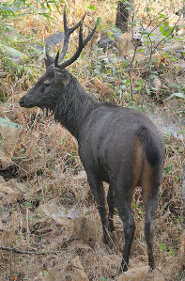
Sambar deer (
Cervus unicolor) are beloved by human sport hunters and by many carnivorous animals still left in the wild. Also called the sambhur deer, fully mature adults can weigh up to 1,200 pounds (546 kg), which is as much as a thoroughbred horse. They grow nearly as tall as horse, too, at 40 to 63 inches tall (102 to 160 cm.) Deer are measured like horses – from the bottom of their hooves to the highest point of their shoulders.
Originally from south and Southeast Asian countries such as India, China, Borneo, Taiwan and Myanmar, herds have been introduced to Australia, New Zealand and three American states, Texas, California and Florida. The deer were introduced solely for the convenience of sport hunters and for gourmands. In the wild, sambar deer are favored prey of lions, tigers, leopards, crocodiles, Southeast Asian wild dogs (dholes) and feral dogs.
General Description
Sambar deer are elk-like in conformation, but sport a longer tail and a shaggy dark mane that stands up when the deer is threatening intruders. They sport a dull grey-brown coat with pale bellies and underneath the tail. Bucks grow a spectacular three-pronged rack that grows about 43 inches (110 cm) long. Adult deer, both does and buck, have a strange hairless red spot mid-way down their throats. Underneath the skin of this spot is a gland that secretes musk.
Sambar deer stamp to communicate to other deer and when danger is present. When really frightened, both adults and fawns can emit high-pitched shrieks. Bucks bellow during the rut but does are quiet. Sambar stags often rub their antlers against tree trunks to mark their territory and may even rear up on their hind legs to do so.
Life and Habits
Sambar deer prefer to live near water. They are not only excellent swimmers, but water can help relieve them of parasites and serve as defense against non-human predators. Smaller predators such as
dholes cannot maneuver in water. Sambar deer have also been found 11,500 feet (3500 meters) up the Himalayan Mountains and snitching illicit snacks out of cultivated fields. Bucks live alone, except during the rut, while females and fawns live in small herds from 2 to 16 individuals.
Does have a gestation lasting seven or eight months. Normally, a single calf is born but twins occur in about 2% of sambar does. Fawns are born with light spots on a chestnut-brown coat, but these spots fade in weeks. They can walk within hours of birth and begin eating solid food at a mere 5 days old. Over the next two months, they transition from milk to an adult diet of twigs, tree bark, leaves, water plants, shrubs, herbs and fruits. Buck calves begin growing antlers when they are one year old. Unlike many other species of deer, calves stay with their mothers for up to 24 months. If lucky, a sambar deer can live nearly 20 years in the wild. The oldest sambar in captivity lived be 38. Sambar deer thrive in captivity.
Picture of the sambar by
Wikigringo, licensed under the
Creative Commons Attribution-Share Alike 2.5 Generic license.
You can help spreading the word about this animal by liking it on facebook
Permanent Link
Wednesday 26 October 2011
Burchell's Zebra - Back from the Brink of Extinction, But for How Long?
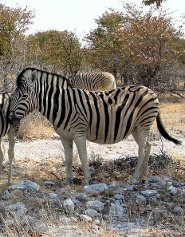
Burchell's zebra (Equus burchellii) (and now Equus quagga burchelli) was thought to become extinct in 1918, when the last Burchell's zebra died at the Berlin Zoo. But after many reports came from Africa about sightings of Burchell's, a major expedition in 2004 showed that Burchell's were not only still alive in the wild, but thriving in the areas of Etosha and Kwazulu-Natal.
But all African wildlife is facing a crisis point, including the numerous Burchell's zebra. With constant civil wars, droughts and an exploding human population, zebra meat is in demand and once wild grasslands are rapidly being turned into farmlands. For thousands of years, zebras thrived despite being hunted by
lions, hyenas,
leopards and
African wild dogs. But they may not be able to escape the most ruthless predator of all --
man.
General Description
Burchell's zebras are one of the smallest subspecies, although the mountain zebra (
Equus zebra) is slightly smaller. Like domesticated horses, zebras have their height measured from the bottom of their hooves to the highest point of their shoulders, called the withers. Stallions are usually larger than mares. Stallions can reach heights of 57 inches (145 cm) while mares average 43.3 (110 cm.) Stallions weigh up to 847 pounds (385 kg) while mares tip the scales at 385 pounds (175 kg.)
The four subspecies of zebra are difficult to differentiate. But Burchell's zebras tend to have very pale legs that appear white from a distance. Up close, the stripes are either non-existent or a very faint brownish-grey, depending on the individual. Their bellies tend to be the same color as the legs instead of being striped, although there usually is one black horizontal stripe from the chest to the tail. Burchell's black body stripes are thicker than for other zebra types.
Coloration Controversy
Common sense states that zebras are black and white. But not the Burchell's. Foals are born with distinctly brown fuzz covering their bodies which gradually disappears as they mature. But not all Burchell's grow up into black and white animals. Many sport dark brown stripes as well as black stripes. Some sport thin light brown stripes in between the black and white stripes. Some have distinctly brown patches on their backs, hindquarters and faces.
It was the latter that got some naturalists and scientists wondering if the Burchell's, plains and possibly other zebra varieties normally were brown and black instead of white and black. One extinct species, the quagga, looks amazingly like a modern day zebra with large brown patches and white legs and a pale belly. Attempts to breed a quagga from zebras has resulted in one colt looking remarkably like any of the stuffed quagga still holed up the world's museums.
You can help spreading the word about this animal by liking it on facebook
Permanent Link
Tuesday 25 October 2011
The Greater Kudu - Corkscrew Horned Beauty
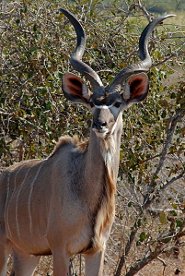
The greater kudu (
Tragelaphus strepsiceros) is a very large and handsome African antelope. The males bear huge spiraling horns that can corkscrew up to three full turns and are arguably, the most spectacular belonging to any antelope in Africa. The average length of a male greater kudu's horns is 48 inches in length, although the largest on record measured 72 inches. Female greater kudus do not have any horns.
Greater kudus are the second tallest antelope in Africa. An adult greater kudu typically stands between four and five feet at the shoulder (100 cm to 160 cm) and can weigh between 264 and 693 pounds (120 to 315 kg). Males are typically about 50 pounds heavier than the females. The coloring of the greater kudu ranges from a reddish brown to taupe to a bluish-gray. The coat on its torso bears approximately six to ten thin, vertical white stripes. The greater kudu's head is marked with a white chevron between its eyes, and it also has small cheek spots. Males greater kudus sport a beard, and both sexes have an upright mane.
The greater kudu can be found in many of the southern countries of Africa, including Zimbabwe, Namibia, Mozambique, Angola, Botswana, South Africa, Swaziland. In east Africa, they can be found in the countries of Djibouti, Sudan, Central African Republic, Eritrea, Ethiopia, Chad, Malawi, the Democratic Republic of the Congo, Kenya, Somalia, Zambia, Uganda and Tanzania. They typically live in scrub woodlands and lightly wooded areas where they can find shelter and where their coloring helps them blend in well with their surroundings.
The greater kudu is a browser that feeds on leaves, vines, flowers and grass. During the dry season, one to three females and their babies will band together for company. In the rainy season, larger groups of up to 20 to 30 greater kudu females may form. Males usually remain solitary, though some do form bachelor groups. During the mating season, males typically try to prove their dominance peacefully with a lateral display in which one male will try to prove to the other he is the bigger animal. Occasionally, male greater kudus will fight for supremacy by battling with their horns. Tragically, the males have been known to accidentally entangle their corkscrewing horns so severely that they cannot get loose and both animals eventually end up dying.
This antelope is a shy animal with large ears that help it hear well. If something frightens it, the greater kudu will bound away in huge leaps. Once it reaches what it believes is safety, it will stop and look back before bounding away again.
Predators of the greater kudu include
lions,
leopards,
spotted hyenas,
cape hunting dogs and
humans. Unfortunately for the greater kudu, its spectacular horns have made it a prized trophy for many hunters, and locals also hunt it for its meat. The greater kudu is not currently regulated by CITES and the IUCN considers them as Least Concern on its list of threatened species.
Picture of the greater kudu by L0k1m0nk33, licensed under
GFDL
You can help spreading the word about this animal by liking it on facebook
Permanent Link
Thursday 20 October 2011
Pacific White-sided Dolphin - Acrobat of the Pacific

The Pacific white-sided dolphin or “lag” (Lagenorhynchus obliquidens) is a familiar sight to boaters from California to
Korea. They regularly leap out of the water and ride the slipstream of boats. Sometimes they leap high and then flop on the water on their sides, as if purposefully making the largest possible splash that they can. Their intense curiosity about boats makes it difficult for scientists to get an accurate number about how many are left in the wild. Pacific white-sided dolphins tend to and from the same boat. Keeping track of which individual dolphin has already investigated a boat is difficult, since the dolphins look alike.
Most Pacific white-sided dolphins migrate to colder Artic waters off of Russia, Canada and Alaska in the summer and then heads to tropical waters such as Japan or Korea for the winter. But some pods or family groups stay in one area year-round, off the coast of Baja, California and do not seem to mind the winter migrants. There may also be a permanent population in
Japan. These Japanese dolphins are much lighter in color than the migrants.
General Appearance
Pacific white-sided dolphins are considered small, averaging a mere 7 to 8 feet (2.1 to 2.4 meters) long and weighing in around 300 pounds (150 kg.) Newborn calves average 31 to 37 inches (80 to 95 cm.) They have a much shorter and more bulbous head than the more familiar bottlenose dolphin.
They are spectacularly colored with swirls of black, dark grey and silvery grey. Darker swirls are on the back, around the eyes and on the tip of the beak or nose. The dorsal fin is mostly pale grey but edged in a sharply contrasting black or charcoal-grey. Dolphins often rest at the surface of the water where some of their back may be seen. The Pacific white-sided dolphin has a bright horizontal stripe on both sides of its dark body. The belly and underside of the tail and flippers are white.
Behavior
Pacific white-sided dolphins seem to delight in each other’s company. Pods of 100 animals are more have been reported, even in the twenty-first century. They also seem curious about other species of dolphins and are friendly with the northern right-whale dolphin (Lagenorhynchus borealis.) Small groups of friends of family members may split off to hunt, but these small groups soon reassemble into huge pods.
All dolphins are carnivorous. They have rarely been observed feeding, leading some scientists to believe they feed at night and spend the daylight hours socializing, playing and snoozing. They eat squid, salmon, herring, sardines, hake, cod and shrimp. They are thought to be prey for large sharks and
killer whales but their main predators are
humans. Although many countries ban whaling, Pacific white-sided dolphins are killed by the thousands by both Japanese fisherman and accidentally in nets intended for other species such as cod and squid.
Future Speculation
With luck, wild Pacific white-sided dolphins can live up to 46. This species has done well in captivity, but needs a huge aquarium in order to remain healthy. Just how many remain in the wild is unknown, although they are currently not listed as an endangered species. However, dolphin meat keeps appearing in black markets, especially in Asia where it is considered a delicacy.
But water pollution is an even bigger threat to the Pacific white-sided dolphin than fisherman. Tests done on beached dolphins on California showed that their bodies contained abnormally high levels of the pesticide DDT and polychlorinated biphenyls (PCBs) used in coolants for machines.
You can help spreading the word about this animal by liking it on facebook
Permanent Link
Wednesday 19 October 2011
Roan Antelope - Goat- and Horse-like Antelope of Africa
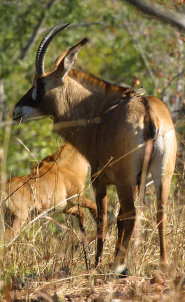
The roan antelope (Hippotragus equinus) appears as if evolution somehow crossed a goat and a horse to produce one of the most common large antelope species found in Central African countries such as Nigeria and Ghana. Both bulls and cows have the cloven hooves and beards of goats, but the long legs and short striped mane of a zebra. They get their common name from roan a color of domesticated horse (Equus caballus.) In horses, roan is a mixture of white hairs plus a base color. In the roan antelope, the colors are vivid white, brown and black.
Domesticated horses did not arrive in Africa until European and Middle Eastern conquerors brought them there. The Linnaean system of taxonomy is based on European perceptions. Since many African countries were colonized by the French, many Africans call the roan antelope “la Antelope Chevaline,” or “horse-like antelope.” Taxonomists and biologists are unsure if the ran antelope has more than one subspecies.
General Description
Roan antelopes have goat-like heads with a broad forehead tapering to a small muzzle. They have long, rabbit-like ears with white insides and dark edges. Their body confirmation is similar to a horse and has a tail and stiff, upright mane like a zebra. Their main coloration is a light brown with a dark dorsal stripe down the back. Their muzzles, hindquarters around the tail and circles around the eyes are white. Bulls have mahogany brown to black heads.
Both bulls and does grow black long, curving horns, but bulls grow longer horns than do does. Bull horns also sport prominent ridges, while doe horns are smoother. Bulls are taller than females. At the highest point of their shoulders, bulls average 4.62 feet (1.4 meters) and females average 4.29 feet (1.3 meters.) Both sexes weigh in at an average of 594 pounds (270 kilograms.) They may not sound like prizefighters, but adult roan antelopes have been known to kill adult lions.
Life Cycle and Behavior
Roan antelopes live in herds similar to wild horses. One dominant male protects a small harem of six to ten females and their offspring. Once bull calves reach sexual maturity at two to three years old, the dominant bull drives them away so they will not compete for breeding rights. This also helps to keep from inbreeding. Although fierce, the roan antelope’s main weapon is their speed. They can gallop up to 35 miles (56.3 kilometers) per hour. Sadly, their speed is no match for a hunter’s gun. The species is being poached for meat and for the spectacular horns.
Bulls rarely fight for supremacy of a herd, but when they do they fight so fiercely that serious injuries or deaths can occur. They clash their horns but also kneel on ground to deliver painful bites. Adults breed year round if food is plentiful. Cows carry their calves for nine months. They usually bear a single calf because a mother cannot produce enough milk to support two calves. With luck, they can live to be 18 years old.
Picture of the Roan antelope by Paul Maritz, licensed under
GFDL
You can help spreading the word about this animal by liking it on facebook
Permanent Link
Monday 17 October 2011
Chinchilla - Magnificent Fur Blessing and Curse
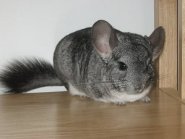
In the unforgiving, wind-swept Andes Mountains of South America, a fur coat so thick that it repels water is a blessing. Long-tailed chinchillas (Chinchilla lanigera) are blessed with such a plush coat. But that same coat is the cause of their critically endangered status in the wild. They have been hunted so ruthlessly for their fur that they are nearly extinct in the wild. Fortunately, they survive well in captivity and make excellent pets.
General Appearance
Long-tailed chinchillas, also called Chilean chinchillas or “chins” by pet owners, are rodents more closely related to guinea pigs than to mice. Their foot long (30.48 cm) bodies are very round with comparatively tiny feet and a long, silky tail an additional 5 to 6 inches (12.7 to 15.2 cm) long. Their heads are more rabbit-like than guinea pig-like with pleasantly prominent ears that are rounded at the tips. Despite their chubby appearance, the largest chins only weigh 2 pounds (0.91 kg.)
Wild chinchillas sport the same color of fur – a silver grey with pale bellies. But domesticated chinchillas come in a variety of colors, including albino, white (with dark eyes) beige, shades of black and a brown-grey shade called lavender. Chinchillas must bathe in dust because the coat takes such a long time to dry that the animal could catch pneumonia. In the Andes Mountains, rain is rare and so the animals evolved to not rely on it.
Behavior
In the wild, chinchillas live in small colonies and eat grass, lichens, seeds and occasionally dead insects. Like any other rodent, chinchilla’s front teeth grow continuously throughout their lives in order to accommodate for their hard diet. In captivity, chinchillas need to eat hard foods and be given chew toys so their teeth do not grow too long.
After a gestation of around 112 days, chinchilla babies are born fully furred with their eyes open and their teeth grown in. They can soon walk after birth and follow after their parents. Both parents help in their care, but the mother winds up doing most of the work. Babies are weaned when they are two months old. They become sexually mature by the time they are eight months old. Living in small colonies means that there are many eyes working together to look out for predators. The chinchilla’s main form of defense is their speed. Despite their comical appearances, chinchillas can sprint in amazingly quick bursts of speed. They rarely run in a straight line but zig-zag and leap to out-maneuver natural predators such as birds of prey.
The Chinchilla Today
Long-tailed chinchillas are one of the rarest mammals to be found in the Andean mountains. Hunting them became outlawed by 1918, although poaching does occur. In the early 1900s, 12 chinchillas, nine males and three females, were brought to the United States by an ex-miner named Matthias F. Chapman. All pet chinchillas in North America are descended from 11 of these 12. One chinchilla turned out to be too old to breed. There are chinchilla farms in many countries of the world where these gentle, friendly animals are killed for their pelts.
Chinchillas are remarkably long-lived for
rodents. Those in captivity have lived as long as 20 years, although the world record holder lived a whopping 26 years. In the wild, their lifespans are considerably shorter but animals living to 15 have been recorded.
You can help spreading the word about this animal by liking it on facebook
Permanent Link
Friday 14 October 2011
The Black Duiker - little diving antelope
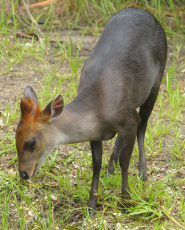
The Black duiker (Cephalophus niger) is a small antelope that lives in West Africa, primarily in the coastal countries of
Guinea through
Nigeria. The average black duiker is only 32 inches (81 cm.) long, 18 inches (45 cm.) tall at the shoulder, and weighs 40 pounds (18 kg.). It makes its home in dense, lowland rainforests or shrublands. This habitat is important to the black duiker as it provides protection from predators, namely eagles and
leopards. In fact, the black duiker is nicknamed the "diving buck" because of its ability to dive for cover into a dense area. It does so using its long hindlegs. A unique feature of this duiker is that its hindlegs are longer than its forelegs, and the length of its legs in addition to its arched back cause the black duiker to have a bouncing gait.
Other physical traits that identify this rarely seen animal include its brown/black color; long, narrow head; short, tassel-like tail; and short (approximately six inches in length), straight horns hidden in a tuft of hair atop its head. The black duiker use these horns to fight one another. This animal is known to live alone or with only one partner and has scent glands below the eyes used to mark territory as well as each other. The black duiker feasts on vegetation such as leaves, fruits and seeds; however, it is also known to consume small birds and rodents and insects. Interestingly, though the duiker is so small, proportionally speaking, it has a larger brain than other antelopes. This may help to explain why this animal has such advanced eyesight, hearing, and sense of smell.
The black duiker appears to breed year-long, and, in captivity, they have been known to have an average lifespan of ten years. As previously mentioned, this animal is rarely seen and is considered to be near threatened as it is a target of not only its natural predators but also hunters who are interested in them for the bushmeat trade as well as their skin.
Picture of the black duiker by
ucumari, licensed under the
Creative Commons Attribution-Share Alike 2.0 Generic license.
You can help spreading the word about this animal by liking it on facebook
Permanent Link
Wednesday 12 October 2011
Musk Ox - Ice Age Survivor
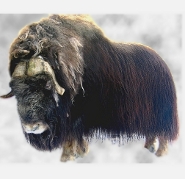
The Ice Age ended about 14,000 years ago, wiping out some majestic large species like the wooly mammoth and the mastodon. But one large mammal survived – the musk ok (
Ovibos moschatus) Musk oxen live in the Artic areas of
Canada and
Greenland. Herds have been successfully introduced to Alaska and Russia. They stand up to five feet tall and can weigh as much as 800 pounds (363.8 kilograms.) Although this is large for an Artic animal today, the musk ox was tiny in comparison to the mammoth and mastodon. Comparatively small bodies need to eat less food.
Herd Structure
Another reason for the survival of the musk ox is the strong herd structure in the species. When a predator messed with one musk ox, it quickly found that it had to deal with the entire angry musk ox herd. Predators would focus on the smaller, weaker calves rather than adults. But in order to protect their calves, adults would form a protective ring around the youngsters, leaving their heavily armed heads to face the predators. Unfortunately, this makes the herd sitting ducks for human hunters, but the strategy does work against their non-human predators such as wolves and grizzly bears.
Both males (bulls) and females (cows) grow curving horns. Females stick together in herds up to 36 individuals with many bulls wandering to and from the female herds. Each female herd will have at least one bull with them that participates in helping to protect the cows and calves from predators. Herds come together in the winter for defense but separate during the breeding season.
Breeding Cycle
In late June, family herds of cows separate to form smaller harems for their favored bulls. Each bull services half a dozen cows during the rutting season. Bulls that are too young or too old to breed form their own herds in order to keep protected from predators. Bulls fight for cows through charging and slamming each other’s heads. At the beginning of winter, around November, the bulls let the cows go back to their larger family herds.
Cows have a gestation that can last up to nine months, but often only lasts eight months. Calves are born with eyes open and are able to stand within a few hours. However, if a calf is unable to keep up with the herd, this usually indicates that the calf is ill or injured. The mother then abandons the calf in order to save her own life. With luck, a musk ox can live for 20 years.
Picture of the musk ox by Dixi, licensed under
GFDL
You can help spreading the word about this animal by liking it on facebook
Permanent Link
Tuesday 11 October 2011
The Shikra - Little but Powerful Raptor
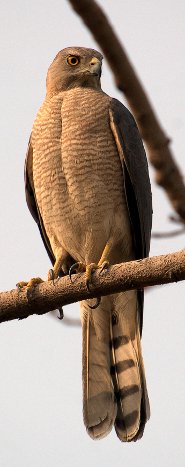
The Shikra (
Accipiter badius) also called the Little Banded Goshawk, the Indian Sparrowhawk, and Little Banded Sparrowhawk is a small, but powerful predator. It is a member of the Family Acciopitridae, which includes eagles, hawks, kites, and osprey. The Shikra has six subspecies ranging primarily from India to Africa. They vary in size from 26-32 cm (10-12 inches) with a wingspan of 55-61 cm (21.5 –24 inches) and weigh an average of 125gm (4.4 oz). The life expectancy is from 2.5–7 years. The female is larger than the male and has dark orange eyes, whereas the male has red eyes. They have a long barred tail that helps them with balance during hunting. The coloring is gray on the head and down the back and pale reddish-orange to white underbelly with darker bars. The coloring varies with the subspecies. The prey also varies over the subspecies. Shikra eat small animals like
birds, lizards, reptiles, amphibians, insects, and squirrels. These little hawks attack from the limbs of trees or from flight as their vision is very acute. Their vision is eight times more acute than the vision of humans. Shikra have strong legs with sharp talons and a sharp, hooked beak, which they use to kill prey and tear it into pieces to eat. They are diurnal, hunting only during the day. They are found in woodlands, savannas, sub tropical, tropical areas and even in populated areas.
Some of the subspecies migrate north to breed during the dry season. The clutch size is two to seven bluish-white eggs. The incubation is 28-30 days. The female incubates the eggs while the male provides her with food. The female takes sole charge of hunting, feeding, and raising of the young. The fledging period is about 30-35 days. The young birds remain in the parents habitat for the first year of their life.
The Shikra is a raptor and is an extraordinary hunter. It swoops down on the prey and kills even poisonous snakes with the hit from the sharp beak. It then takes the prey to a perch on a tree limb to eat. In turn, the Shikra is prey to larger raptors, snakes, large carnivorous mammals, as well as domestic cats and dogs. The Shikra is listed on the endangered species list as "Least Concern" or not endangered at this time. This small, powerful little goshawk is thought to number over a million in population over the two continents.
Picture of the skira by Ravi Vaidyanathan, licensed under
GFDL
You can help spreading the word about this animal by liking it on facebook
Permanent Link
Monday 10 October 2011
Weasel Sportive Lemur - adapts to stay wild
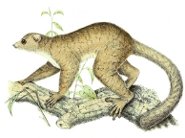
The Weasel Sportive Lemur (
Lepilemur mustelinus), are found natively in the deciduous forests of both East and West
Madagascar. They are island endemic meaning this is the only location in the world they are found. The forests are considered tropical and very humid. These animals are nocturnal so they can be found sleeping in hollow portions of trees during the day. In rare cases, weasel sportive lemurs are found in open nests when predators are not common to the area.
Adults can weigh anywhere between 500 and 900 grams (17.6oz to 32oz) and have a head and body measurement of 24 to 30 centimeters ( 9.5 to 11.8 inches) with tales that can be almost as long as their bodies. Proportionally, tale length will always be slightly shorter than the head and body length of the animal and rear legs are much longer than front arms. In general, these animals are brown to gray on their backs with the undersides being lighter in color. They possess a very dense woolly.
Often, weasel sportive lemurs will live solitary lives. Males have a larger territory and may cross into regions of two or three females for mating. Mating occurs in late spring and early summer, when a female is in estrous there is a characteristic swelling of her genitalia signaling males of receptiveness. Gestation will last for about 135 days and will result in a single offspring. Weaning occurs at four months but young stay with their mothers until the next birth occurs the following year. At eighteen months both males and females will reach sexual maturity. Weasel sportive lemurs spend a large amount of time in trees and move about by leaping from tree to tree or by vertically leaping up limbs. Despite their small stature, these animals can leap an average of five meters in a single jump.
Weasel sportive lemurs are considered endangered species, their habitat is being removed for agricultural purposes and the animals are often hunted for their meat. Predators include snakes and any carnivorous species large enough to capture them, for example the
fossa. These animals benefit their ecosystem by dispersing seeds. The weasel sportive lemur has been unsuccessful in multiple captivity settings and has diversified itself from similar species in its ability to digest high levels of cellulose.
You can help spreading the word about this animal by liking it on facebook
Permanent Link
Friday 07 October 2011
Sable Antelope - Scythe-horned Beauty
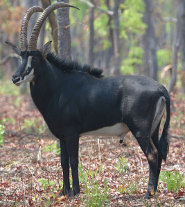
The sable antelope (Hippotragus niger) is one of Africa's most beautiful and striking antelopes. It boasts a dainty head, graceful backward curving horns, a brushy upright mane, and a sleek coat. There are four subspecies of sable antelope including the common or southern, the Zambian or Kirk's, the Roosevelt or Eastern, and the giant or Angolan. Depending on the subspecies, the coat of a mature male sable antelope is typically a dark brown to black in color. The female's coat is generally more a rich sorrel or chestnut in color.
Both males and females have white markings on their face and bellies and a dark marking around the eyes that serve to make them appear larger than they actually are. Females and males both have horns, although those of the males tend to be larger. Baby sable antelopes are born a light sandy brown, and their coats darken as they mature.
The Sable antelope is typically about 4 feet to 4 feet 7 inches -- 117 to 143 cm -- at its shoulder and approximately 6 feet to 8.5 feet -- 195 to 255 cm -- in length. Its weight ranges from 420 to 595 pounds, which is approximately 190 to 270 kg.
A herd of sable antelope is typically made up of 15 to 20 females and only 1 mature male, although they do occasionally form larger groups that can number in the hundreds. Younger males are allowed to stay with their herd until they are about three years old. At that point, the head bull will force the young male out of the herd. Young males typically band together to form bachelor groups.
The sable antelope is an herbivore and feeds on grass, trees and bushes. Its habitats of choice are the grasslands and woodlands of the savanna. Sable antelopes normally live within two miles of a source of water. Currently, this animal's range extends from southern
Kenya down to
South Africa and westwards into central
Angola. Giant sables are found only in Angola.
Predators of this large antelope include lions, leopards, wild dogs, crocodiles and spotted hyenas. When pursued, the sable can reach speeds of up to 35 miles per hour. It will also try to defend itself with its horns when cornered.
Currently, three of the subspecies, the Kirk, Roosevelt and Common are listed as Lower Risk-Conservation Dependent by CITES, the Convention on International Trade in Endangered Species of Wild Fauna and Flora. The giant sable, unfortunately, is listed as critically endangered by several organizations, including CITES and IUCN. Over-hunting and loss of habitat are the primary reason these antelope have declined, and it is believed that only 1,000 giant sables remain alive in the wild.
Picture of the sable antelope by Paul Maritz, licensed under
GFDL
You can help spreading the word about this animal by liking it on facebook
Permanent Link
Wednesday 05 October 2011
Harbor Porpoises - Polluted in the Harbor
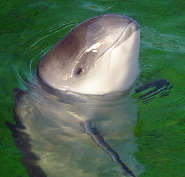
The harbor porpoise (
Phocoena phocoena) is perhaps the most common of all the species of porpoises in existence today. Other porpoise species in existence include the
finless porpoise,
vaquita,
spectacled porpoise, burmeister’s porpoise and the
dall's porpoise. Porpoises are in the whale and dolphin family, all belonging to the order Cetacea. Harbor porpoises are often spotted in the harbors, bays, estuaries, fjords, rivers and other inland areas of the North Atlantic, North Pacific and Black Sea coastal waters, thus earning their name.
The harbor porpoise is a small, hardy marine mammal ranging in weight from 61 to 77 kg (135-170 lbs) and in length from 1.5 to 1.7 m (5 to 5.5 ft) long. Female porpoises are typically larger than males. Unlike the black and white coloration of the dall’s and spectacled porpoises, the harbor porpoise is dark gray to dark brown in color with a white belly. Harbor porpoises are known for their short, blunt beaks, rounded heads, triangular dorsal fins and small spade-shaped teeth. They can be found alone or in groups of up to five other porpoises, sometimes even more. Their diet consists of small fish including cod, herring, pollock, sardines, mackerel, capelin, whiting and squid. Because of their small size and lack of stored fat, they feed often throughout the day. The life expectancy of this species is approximately 15-20 years.
Unlike the vaquita porpoise, harbor porpoises are not considered endangered, though their numbers are declining. They are not typically hunted by whalers and commercial fishermen, but are often trapped in fishing nets and harmed by other fishing equipment such as fish weirs and lines. They are also affected by pollution. It is estimated that thousands of harbor porpoises die every year due to these factors. Many organizations, such as the Humane Society, have been actively fighting against net entanglement in order to protect the harbor porpoise species. Though not typically hunted by humans, they fall prey to natural predators, such as
killer whales and large sharks. Mature female harbor porpoises only give birth to one calf a year making the process of replenishing the species relatively slow.
Picture of the harbor porpoise by AVampireTear, licensed under
GFDL.
You can help spreading the word about this animal by liking it on facebook
Permanent Link
Tuesday 04 October 2011
The Goral: Threatened Mountain Goat of the Himalayas
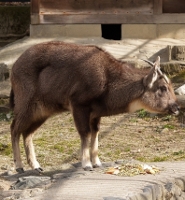
Also called the grey goral, the Himalayan goral (
Naemorhedus goral) is a goat-like creature so rare that it is listed as a nearly threatened species by the International Union for the Conservation of Nature. Native people in the Himalayas find it difficult to grow crops and so exist on a meat-based diet. Gorals are hunted for meat, for their fur, for sport and to harvest parts for folk medicine that can be sold as far away as
South Korea.
Nimble on the Hills
Gorals don’t make easy targets for human hunters. They can race up sheer rock-strewn slopes as easily as a cow walks across a meadow. Gorals coloration of a muted grey-brown helps them blend in with their surroundings. Unless they move, gorals are particularly hard to spot. Gorals can easily exist up to 9800 feet (3000 meters) above sea level. The oxygen is too thin for most people except the native peoples of the Himalayas.
To help their camouflage be more effective, gorals sleep during the day. They become very active around dawn and dusk. They feed at dawn on whatever vegetation they can find, including bare twigs and spend the remainder of the day laying down and ruminating. In order to digest their harsh diet, the food needs to come back up the throat, be re-chewed and swallowed again.
Natural Predators
Gorals may be the last hope for the Amur tiger, the
lynx and the
snow leopard. In recent years, scientists were stunned to learn that these remarkably rare predators actively hunted gorals. Both big cats and gorals need large areas in order to survive because of the lack of resources in the mountains. One goral herd of about ten animals needs about 100 acres (40 hectares) in order to survive. This suits the big cats just fine.
Gorals are so fast and nimble that natural predators need to creep up as close as possible to one before charging. If the wind blows just right, a cat can creep above a resting goral and then race down onto the prey before it can leap up and gain momentum. Gorals have far superior powers of stamina, but are equal in speed to their predators when it comes to sprints. Gorals warn others of danger by hissing and snorting in a way that sounds to people like a sneeze.
Picture of Himalayan goral by
OpenCage, licensed under
Creative Commons Attribution-Share Alike 2.5 Generic license.
You can help spreading the word about this animal by liking it on facebook
Permanent Link
Monday 03 October 2011
Tonkean Macaque - Social Creatures
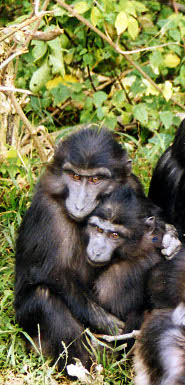
Tonkean macaques (
Macaca tonkeana) belong to the order Primates. They are part of the Cercopithecidae family, also known as Old World monkeys and are the biggest out of all the macaque species. They are native to Sulawesi in
Indonesia.
Tonkean macaques are very social animals, perhaps more social than many others in their species. They love climbing, playing and swinging in the trees of the tropical forests. They also spend a lot of time on the ground with other male and female members of their troop. Juvenile tonkean macaques enjoy play-fighting while the female primates go about their grooming rituals. Unlike many other primates, tonkean macaques have no dominance hierarchies and are not considered to be aggressive towards each other. In order to keep peace within the troop, a third adult will often intervene when two adults engage in a squabble. Female tonkean macaques give birth to one offspring at a time.
Tonkean macaques are strong, hardy primates and are dark brown to black in color with gray cheek tufts and ember colored eyes. They have long snouts and short tails, from one to two inches long. Their weight typically ranges between 8.6 kg (19 lbs) to 10.4 kg (23 lbs) and their length ranges from 500 mm (19.7 in) to 675 mm (26.6 in). Diet includes fruit, leaves, flower stalks, buds, bamboo seeds and some insects and they have been known to raid cultivated crops for maize and other vegetables. Because of their plundering behavior, they are considered to be agricultural pests and are often poisoned, trapped and destroyed. The lifespan of this species is currently unknown.
Tonkean macaques are considered to be vulnerable by the International Union for Conservation of Nature (IUCN). Besides being trapped and killed by crop owners, these primates are also being trapped and used for food and for domestication. Their habitat is in danger as well. Their land is being used more and more for oil palm plantations, cacao plantations, as well as for human settlements. Members of the macaque species are often used for animal testing. Predators of the macaque species include large cats and large reptiles, but the biggest threat are humans.
You can help spreading the word about this animal by liking it on facebook
Permanent Link
 The steppe polecat (Mustela eversmannii), also called the masked polecat, Eversmann’s polecat or the Siberian polecat, strongly resembles a pet ferret (Mustela putorious fero.) Although biologists think the European polecat (Mustela putorious) is the direct ancestor of the domesticated ferret because the two species can interbreed, some biologists think that the steppe polecat may also be an ancestor to the pet ferret. Unlike domesticated ferrets, steppe polecats do not come in a variety of coat colors and are hostile to people.
The steppe polecat (Mustela eversmannii), also called the masked polecat, Eversmann’s polecat or the Siberian polecat, strongly resembles a pet ferret (Mustela putorious fero.) Although biologists think the European polecat (Mustela putorious) is the direct ancestor of the domesticated ferret because the two species can interbreed, some biologists think that the steppe polecat may also be an ancestor to the pet ferret. Unlike domesticated ferrets, steppe polecats do not come in a variety of coat colors and are hostile to people.
 The Japanese macaque (Macaca fuscata), which is also known as the snow monkey, is famous throughout the world for its love of soaking in hot springs on cold winter days. This very human-like behavior has endeared them to those who have seen images of the little monkeys, their fur covered in snow, peeping out from the steaming water.
The Japanese macaque (Macaca fuscata), which is also known as the snow monkey, is famous throughout the world for its love of soaking in hot springs on cold winter days. This very human-like behavior has endeared them to those who have seen images of the little monkeys, their fur covered in snow, peeping out from the steaming water. Sambar deer (Cervus unicolor) are beloved by human sport hunters and by many carnivorous animals still left in the wild. Also called the sambhur deer, fully mature adults can weigh up to 1,200 pounds (546 kg), which is as much as a thoroughbred horse. They grow nearly as tall as horse, too, at 40 to 63 inches tall (102 to 160 cm.) Deer are measured like horses – from the bottom of their hooves to the highest point of their shoulders.
Sambar deer (Cervus unicolor) are beloved by human sport hunters and by many carnivorous animals still left in the wild. Also called the sambhur deer, fully mature adults can weigh up to 1,200 pounds (546 kg), which is as much as a thoroughbred horse. They grow nearly as tall as horse, too, at 40 to 63 inches tall (102 to 160 cm.) Deer are measured like horses – from the bottom of their hooves to the highest point of their shoulders. Burchell's zebra (Equus burchellii) (and now Equus quagga burchelli) was thought to become extinct in 1918, when the last Burchell's zebra died at the Berlin Zoo. But after many reports came from Africa about sightings of Burchell's, a major expedition in 2004 showed that Burchell's were not only still alive in the wild, but thriving in the areas of Etosha and Kwazulu-Natal.
Burchell's zebra (Equus burchellii) (and now Equus quagga burchelli) was thought to become extinct in 1918, when the last Burchell's zebra died at the Berlin Zoo. But after many reports came from Africa about sightings of Burchell's, a major expedition in 2004 showed that Burchell's were not only still alive in the wild, but thriving in the areas of Etosha and Kwazulu-Natal. The greater kudu (Tragelaphus strepsiceros) is a very large and handsome African antelope. The males bear huge spiraling horns that can corkscrew up to three full turns and are arguably, the most spectacular belonging to any antelope in Africa. The average length of a male greater kudu's horns is 48 inches in length, although the largest on record measured 72 inches. Female greater kudus do not have any horns.
The greater kudu (Tragelaphus strepsiceros) is a very large and handsome African antelope. The males bear huge spiraling horns that can corkscrew up to three full turns and are arguably, the most spectacular belonging to any antelope in Africa. The average length of a male greater kudu's horns is 48 inches in length, although the largest on record measured 72 inches. Female greater kudus do not have any horns. The Pacific white-sided dolphin or “lag” (Lagenorhynchus obliquidens) is a familiar sight to boaters from California to
The Pacific white-sided dolphin or “lag” (Lagenorhynchus obliquidens) is a familiar sight to boaters from California to  The roan antelope (Hippotragus equinus) appears as if evolution somehow crossed a goat and a horse to produce one of the most common large antelope species found in Central African countries such as Nigeria and Ghana. Both bulls and cows have the cloven hooves and beards of goats, but the long legs and short striped mane of a zebra. They get their common name from roan a color of domesticated horse (Equus caballus.) In horses, roan is a mixture of white hairs plus a base color. In the roan antelope, the colors are vivid white, brown and black.
The roan antelope (Hippotragus equinus) appears as if evolution somehow crossed a goat and a horse to produce one of the most common large antelope species found in Central African countries such as Nigeria and Ghana. Both bulls and cows have the cloven hooves and beards of goats, but the long legs and short striped mane of a zebra. They get their common name from roan a color of domesticated horse (Equus caballus.) In horses, roan is a mixture of white hairs plus a base color. In the roan antelope, the colors are vivid white, brown and black. In the unforgiving, wind-swept Andes Mountains of South America, a fur coat so thick that it repels water is a blessing. Long-tailed chinchillas (Chinchilla lanigera) are blessed with such a plush coat. But that same coat is the cause of their critically endangered status in the wild. They have been hunted so ruthlessly for their fur that they are nearly extinct in the wild. Fortunately, they survive well in captivity and make excellent pets.
In the unforgiving, wind-swept Andes Mountains of South America, a fur coat so thick that it repels water is a blessing. Long-tailed chinchillas (Chinchilla lanigera) are blessed with such a plush coat. But that same coat is the cause of their critically endangered status in the wild. They have been hunted so ruthlessly for their fur that they are nearly extinct in the wild. Fortunately, they survive well in captivity and make excellent pets. The Black duiker (Cephalophus niger) is a small antelope that lives in West Africa, primarily in the coastal countries of
The Black duiker (Cephalophus niger) is a small antelope that lives in West Africa, primarily in the coastal countries of  The Ice Age ended about 14,000 years ago, wiping out some majestic large species like the wooly mammoth and the mastodon. But one large mammal survived – the musk ok (Ovibos moschatus) Musk oxen live in the Artic areas of
The Ice Age ended about 14,000 years ago, wiping out some majestic large species like the wooly mammoth and the mastodon. But one large mammal survived – the musk ok (Ovibos moschatus) Musk oxen live in the Artic areas of  The Shikra (Accipiter badius) also called the Little Banded Goshawk, the Indian Sparrowhawk, and Little Banded Sparrowhawk is a small, but powerful predator. It is a member of the Family Acciopitridae, which includes eagles, hawks, kites, and osprey. The Shikra has six subspecies ranging primarily from India to Africa. They vary in size from 26-32 cm (10-12 inches) with a wingspan of 55-61 cm (21.5 –24 inches) and weigh an average of 125gm (4.4 oz). The life expectancy is from 2.5–7 years. The female is larger than the male and has dark orange eyes, whereas the male has red eyes. They have a long barred tail that helps them with balance during hunting. The coloring is gray on the head and down the back and pale reddish-orange to white underbelly with darker bars. The coloring varies with the subspecies. The prey also varies over the subspecies. Shikra eat small animals like
The Shikra (Accipiter badius) also called the Little Banded Goshawk, the Indian Sparrowhawk, and Little Banded Sparrowhawk is a small, but powerful predator. It is a member of the Family Acciopitridae, which includes eagles, hawks, kites, and osprey. The Shikra has six subspecies ranging primarily from India to Africa. They vary in size from 26-32 cm (10-12 inches) with a wingspan of 55-61 cm (21.5 –24 inches) and weigh an average of 125gm (4.4 oz). The life expectancy is from 2.5–7 years. The female is larger than the male and has dark orange eyes, whereas the male has red eyes. They have a long barred tail that helps them with balance during hunting. The coloring is gray on the head and down the back and pale reddish-orange to white underbelly with darker bars. The coloring varies with the subspecies. The prey also varies over the subspecies. Shikra eat small animals like  The Weasel Sportive Lemur (Lepilemur mustelinus), are found natively in the deciduous forests of both East and West
The Weasel Sportive Lemur (Lepilemur mustelinus), are found natively in the deciduous forests of both East and West  The sable antelope (Hippotragus niger) is one of Africa's most beautiful and striking antelopes. It boasts a dainty head, graceful backward curving horns, a brushy upright mane, and a sleek coat. There are four subspecies of sable antelope including the common or southern, the Zambian or Kirk's, the Roosevelt or Eastern, and the giant or Angolan. Depending on the subspecies, the coat of a mature male sable antelope is typically a dark brown to black in color. The female's coat is generally more a rich sorrel or chestnut in color.
The sable antelope (Hippotragus niger) is one of Africa's most beautiful and striking antelopes. It boasts a dainty head, graceful backward curving horns, a brushy upright mane, and a sleek coat. There are four subspecies of sable antelope including the common or southern, the Zambian or Kirk's, the Roosevelt or Eastern, and the giant or Angolan. Depending on the subspecies, the coat of a mature male sable antelope is typically a dark brown to black in color. The female's coat is generally more a rich sorrel or chestnut in color.  The harbor porpoise (Phocoena phocoena) is perhaps the most common of all the species of porpoises in existence today. Other porpoise species in existence include the
The harbor porpoise (Phocoena phocoena) is perhaps the most common of all the species of porpoises in existence today. Other porpoise species in existence include the  Also called the grey goral, the Himalayan goral (Naemorhedus goral) is a goat-like creature so rare that it is listed as a nearly threatened species by the International Union for the Conservation of Nature. Native people in the Himalayas find it difficult to grow crops and so exist on a meat-based diet. Gorals are hunted for meat, for their fur, for sport and to harvest parts for folk medicine that can be sold as far away as
Also called the grey goral, the Himalayan goral (Naemorhedus goral) is a goat-like creature so rare that it is listed as a nearly threatened species by the International Union for the Conservation of Nature. Native people in the Himalayas find it difficult to grow crops and so exist on a meat-based diet. Gorals are hunted for meat, for their fur, for sport and to harvest parts for folk medicine that can be sold as far away as  Tonkean macaques (Macaca tonkeana) belong to the order Primates. They are part of the Cercopithecidae family, also known as Old World monkeys and are the biggest out of all the macaque species. They are native to Sulawesi in
Tonkean macaques (Macaca tonkeana) belong to the order Primates. They are part of the Cercopithecidae family, also known as Old World monkeys and are the biggest out of all the macaque species. They are native to Sulawesi in